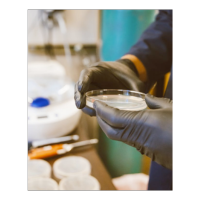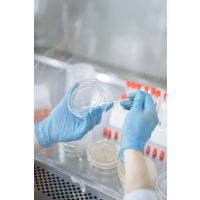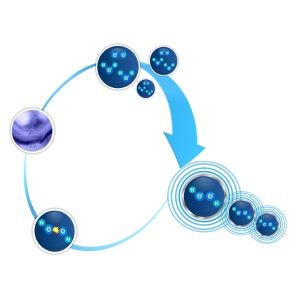4 Environmental Monitoring Methods That Can Help Shape Your Facility’s Decontamination Protocol
Environmental monitoring is a universal process and has been implemented into many industries, including laboratories, cleanroom pharmaceutical manufacturing facilities, the medical device industry, and even hospitals. The samples collected during this process help the facility narrow down the specific areas in which microbial contamination is occurring and help prevent cross contamination from one area to the next. Over time, long-term trends give insight into vulnerable areas and prevent future lapses in those locations. Each facility falls into categories and is required to conduct environmental monitoring routinely according to GMP (Good Manufacturing Practices) guidelines to achieve appropriate safety standards, especially in sterile cleanrooms.
Environmental monitoring is required for multiple reasons, including:
- Microbes can contaminate medical devices and lead to dangerous infections if vulnerable and immunocompromised patients.
- Microbial contamination can interfere with the pharmacological structure of drugs, making them more, or less, potent (depending on the drug). Monitoring can also detect this contamination before the product is created or released to consumers.
- To ensure the facilities are taking adequate measures to keep their facilities safe.
- In non-sterile environments, it helps to verify that appropriate levels of contamination control are occurring and not exceeding the accepted threshold.
- In sterile environments, for verified sterility and aseptic processes.
Environmental Monitoring Assessments and Processes
Four common tests are completed during environmental monitoring to assess the facility. They include contact plating, passive air sampling, active sampling, and swabs.
-
Contact Plates

These plates are often used to monitor cleanroom, isolators, and other surfaces. However, they may also be implemented to monitor personnel. Contact plates are ideal because they are able to detect a wide range of microbes from gram-positive bacteria, bacterial spores, gram-negative bacteria, yeasts, molds, and even anaerobic bacteria. (Cleanroom Technology, Validation of Contact Plates for Environmental Monitoring).
-
Passive Air Sampling (Settle Plate Method)
Passive air sampling is used to detect microbes and contaminants that are found suspended in the air at the facility. Each plate is placed in the room or facility and left with the pre-incubated agar exposed for a set amount of time. This is somewhere between a few hours to months (depending on the facility) (PharmaGuideline.com). After this time has ended, the plate will be re-incubated and evaluated for the presence of microbial contamination like fungi and bacteria.
-
Active Sampling
This method is very similar to passive air sampling; however, these plates are placed in an area that receives a continuous flow of air. Microbes that are contaminating this area will settle on the plate and then be incubated to determine if contamination is present. This method is popular because it can be done very quickly (usually in about 10 minutes), unlike its counterpart.
-
Swabs

Swabs are an immensely popular environmental monitoring test because they are simple and accurate. The cotton swab itself has been pre-sterilized and then wiped on a surface using overlapping stroke. Once the sample has been collected, it can be placed in an incubator for 3 days and then examined to determine the level of contamination. These may also be used after a decontamination treatment to ensure the reduction of microorganisms.
Using Results from Environmental Monitoring to Shape Your Contamination Control Process
Once the results have been collected and recorded, they can be used to formulate a decontamination treatment plan that works best for your facility. This often means looking at your decontamination products and determining if they are adequately achieving their goals. If they are not, it might be time to switch to an automated disinfection treatment.
Breaking New Ground with CURIS HHP™ Automated Biodecontamination Technology
CURIS System’s Hybrid Hydrogen Peroxide™ (HHP™) technology is cutting edge in the world of biodecontamination technology. It's proven successful across multiple applications and offers full automation for ease of use. Since it reaches everywhere air touches, it has been previously used in filter banks and HEPA systems, which are important during environmental monitoring treatments.
 Hybrid hydrogen peroxide™ breaks down into water and oxygen, with no corrosive or sticky residues left behind, making CURIS a clear advantage for a facility's decontamination toolbox. The automated component eliminates the need to have staff in the room during the treatment. This protects them from the chemical and can help reduce cross contamination associated with traditional wiping methods.
Hybrid hydrogen peroxide™ breaks down into water and oxygen, with no corrosive or sticky residues left behind, making CURIS a clear advantage for a facility's decontamination toolbox. The automated component eliminates the need to have staff in the room during the treatment. This protects them from the chemical and can help reduce cross contamination associated with traditional wiping methods.
CURIS offers decontamination systems designed to treat an entire laboratory or a specific fill finish isolator. Whether it’s a fixed integrated system or a versatile portable system, the CURIS line of products has scalable solutions for your sensitive space.
The Future of Environmental Monitoring Using CURIS System
Environmental monitoring remains a necessity in a variety of fields as a method to drive safety precautions and help formulate adequate decontamination protocols to keep both staff and consumers safe. HHP™ technology can be a powerful adjunct to every decontamination protocol.
Sources:
Choudhary, A. (n.d.). Requirement of Active and Passive Air Sampling in Controlled Areas. Pharmaguideline. https://www.pharmaguideline.com/2017/07/requirement-of-active-and-passive-air-sampling.html